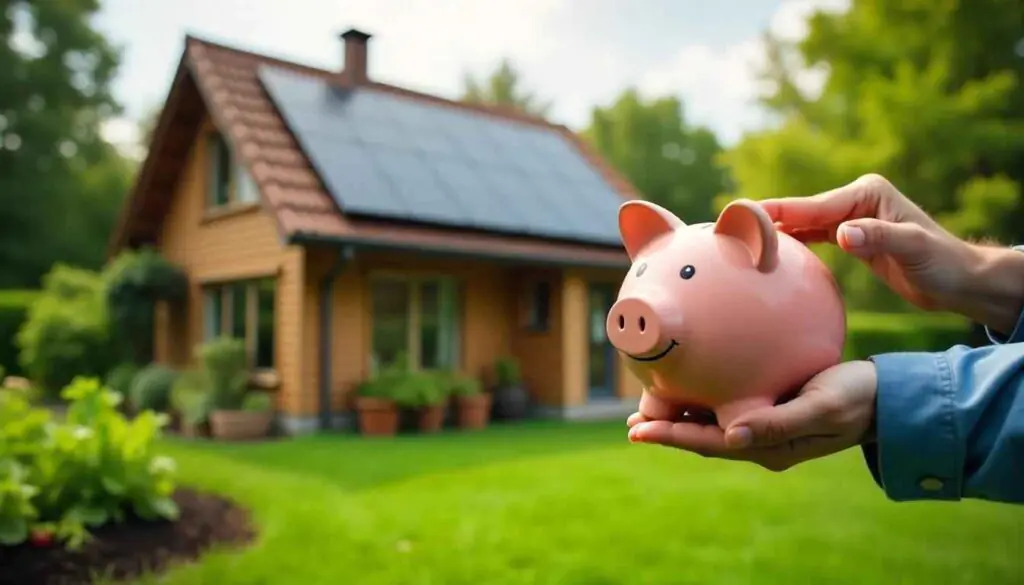Introduction
As environmental concerns heighten and awareness of climate change increases, many individuals are seeking ways to adopt a sustainable lifestyle. Living green is no longer just a trend; it has become a necessary approach to ensuring the longevity of our planet. This shift entails making conscious choices that positively influence both the environment and our finances. The essential question arises: how to save money while living green without compromising on style?

Embracing sustainable living allows individuals to reduce their carbon footprint while also enhancing their personal style. It presents avenues for creativity and innovation, encouraging individuals to explore alternative fashion materials and eco-friendly products that mirror contemporary trends. By merging style with sustainability, it becomes evident that living green can be both fashionable and pocket-friendly.
The financial implications of living sustainably can be significant. Many energy-efficient and environmentally friendly practices lead to substantial savings over time. For instance, utilizing renewable energy sources, reducing waste, and adopting minimalistic approaches can alleviate monthly expenses. Investing in high-quality, durable products can also minimize the frequency of replacements, ultimately fostering long-term financial prudence.
The notion that eco-conscious living equates to sacrificing personal aesthetics is a misconception that needs to be addressed. Fashion and sustainability can exist harmoniously, offering a plethora of options that reflect both environmental responsibility and individual style. For example, one can easily find stylish clothing produced from sustainable materials or discover chic home décor items that support eco-friendly practices.
In exploring the intersection of sustainability, style, and savings, we can uncover methods that are not only beneficial to our wallets but also to the planet. As we delve deeper into this subject, readers will be armed with seven genius strategies on how to save money while living green, enriching their lifestyles without the need to compromise on taste.
Also Read Trending Post
- 20 High Protein Meal Prep Ideas for Weight Loss, Muscle Gain & Busy Lifestyles (2025 Guide)
- Healthy and Sustainable Rooftop Gardening Guide for Beginners: Simple and Effective Methods
- Eco-Friendly Meal Prep Ideas: 10 Essential Tips for Healthy and Sustainable Eating
- Microplastics: Invisible Danger in Our Food, Water, and Environment
- Top 25 Plant-Based Protein Sources Chart: Your Ultimate Visual Guide for a Healthier Diet!
01: Embrace Thrift Shopping: Chic Finds on a Budget
Thrift shopping is an increasingly popular trend that effectively aligns sustainability with style and cost savings. By choosing to shop at thrift stores, individuals can find unique, high-quality fashion items at a fraction of the original price. This approach not only allows one to save money while living green but also fosters a creative and personal sense of fashion that cannot be easily replicated through mainstream retail channels.
One of the key benefits of thrift shopping is the contribution it makes to waste reduction. By purchasing second-hand items, consumers actively participate in slowing down the cycle of production and consumption. This practice decreases the number of clothes sent to landfills and supports a circular economy where resources are reused and reimagined. Moreover, thrift stores often curate collections that include vintage clothing, which not only adds character to one’s wardrobe but also promotes sustainable fashion choices.
To maximize the benefits of thrift shopping, a few strategies can enhance the experience. First, developing a keen eye for quality is essential—look for durable fabrics, sturdy stitching, and classic styles that can easily be integrated into various outfits. Understanding how to style thrifted pieces is equally important; mixing high-end items with thrift finds can create a balanced look that showcases individual style without significant financial outlay.
Furthermore, exploring different places to thrift can reveal hidden treasures. From local charity shops to larger chain thrift stores, each location can offer distinct items. Online thrift stores and reselling platforms also provide an excellent avenue for finding desirable fashion pieces from the comfort of home. By embracing thrift shopping as a savvy alternative, one can truly discover how to save money while living green, all while maintaining an impeccable sense of style.
02: Create a Capsule Wardrobe: Minimalism Meets Style
A capsule wardrobe is a minimalist approach to fashion that focuses on a small number of carefully selected clothing items that can be mixed and matched to create a variety of stylish outfits. This concept not only simplifies the daily task of choosing what to wear, but also promotes sustainability and contributes to a more eco-friendly lifestyle. By reducing excess consumption, a capsule wardrobe allows individuals to save money while living green, all without sacrificing personal style.
To curate an effective capsule wardrobe, begin by evaluating your current clothing collection. Identify pieces that you love and wear frequently, as well as those that remain unworn. This process helps you understand your personal style and eliminates unnecessary items. Focus on selecting versatile pieces that can be dressed up or down, such as classic tops, tailored trousers, and well-fitting dresses. Neutral colors and timeless patterns are excellent choices, as they provide a solid foundation for countless outfit combinations.

Prioritizing quality over quantity is essential when building a capsule wardrobe. Instead of purchasing numerous low-cost items, invest in a few higher-quality pieces that will last longer and withstand the test of time. Look for sustainable brands that prioritize ethical production and environmentally-friendly materials, as these align with the principles of living green. Furthermore, consider incorporating second-hand clothing into your capsule wardrobe; thrift stores and online resale platforms often offer high-quality garments at significantly reduced prices.
Overall, creating a capsule wardrobe is a practical way to save money while living green. By adopting this minimalist approach to fashion, you can streamline your clothing choices, curate a stylish collection, and effectively promote sustainability through your wardrobe choices.
03: DIY and Upcycling: Transforming Old into New
Adopting a sustainable lifestyle often implies making conscious decisions that can positively impact both the environment and one’s finances. One of the most effective and economical methods to embrace an eco-friendly approach is through DIY projects and upcycling. By transforming old items into new, stylish creations, individuals can save money while living green.
The DIY trend has gained significant traction as people discover the potential of repurposing their existing belongings. From home décor to clothing alterations, there is a plethora of projects that can add unique character to one’s living space or wardrobe. For instance, an old pair of jeans can be reshaped into a trendy tote bag, combining utility with a fashionable flair. Similarly, turning outdated furniture into eye-catching pieces can infuse a fresh aesthetic into one’s home without the expense of purchasing brand-new items.
Engaging in these creative endeavors facilitates significant savings and provides personal satisfaction and a sense of accomplishment. Learning how to save money while living green is achievable through the sheer enjoyment of repurposing materials. By utilizing what already exists, you can effectively minimize waste while nurturing your creativity and style.
Moreover, numerous online and offline resources are available to guide enthusiasts in their DIY adventures. Websites, social media platforms, and local community workshops often showcase innovative ideas for upcycling common household items. As individuals explore these avenues, they not only enhance their own style at a fraction of the cost but also contribute to a larger environmental cause.
To conclude, embracing DIY and upcycling can offer remarkable financial benefits while promoting a sustainable lifestyle. These strategies exemplify how to save money while living green without sacrificing one’s personal style, making them a win-win choice for the environmentally conscious consumer.
04: Choose Sustainable Brands: Ethical Shopping Choices
Embarking on a journey to live a more sustainable lifestyle doesn’t mean compromising on style. One of the most impactful ways to save money while living green is by making informed choices about the brands you support. Choosing sustainable brands is a crucial aspect of ethical consumerism, which emphasizes purchasing products from companies that prioritize environmental responsibility and social ethics.
When searching for stylish, eco-friendly clothing options, consider looking into brands that utilize organic materials, recyclable fabrics, and ethical production methods. Many sustainable brands advocate for fair labor practices and are transparent about their supply chains, allowing consumers to make better-informed choices. By investing in high-quality items from these brands, you not only enhance your wardrobe with unique pieces but also contribute to a larger movement aimed at reducing the negative impact of fashion on the planet.
Although sustainable brands may seem more expensive initially, they often offer substantial long-term financial benefits. By choosing durability over disposability and opting for timeless styles, you are likely to reduce your overall spending. Fast fashion often leads to a cycle of constant purchasing due to low-quality and trend-driven products. In contrast, when you invest in sustainable options, you are more likely to have clothing that lasts longer and remains stylish throughout various seasons, ultimately saving you money in the long run.
Additionally, consider shopping at thrift stores or consignment shops that specialize in gently-used items from sustainable brands. This approach allows you to find unique pieces without directly contributing to the industry’s environmental burden. By consciously choosing where you shop and investing in sustainable brands, you can effectively learn how to save money while living green, without sacrificing the style you desire.
05: Energy Efficiency for Stylish Living: Eco-Friendly Home Decor
Creating an energy-efficient home while maintaining an elegant aesthetic is entirely achievable with the right strategies and choices. When contemplating how to save money while living green, it is essential to focus on both functionality and style in your home decor. Start by selecting energy-efficient appliances, which can significantly reduce energy consumption and lower utility bills. Opt for appliances that are ENERGY STAR certified; these products use less energy without compromising on performance or design.
In terms of home decor, consider incorporating sustainable and biodegradable materials. Furniture made from reclaimed wood or sustainably sourced materials not only contributes to a healthier planet but also adds a unique charm to your living space. Bamboo is another excellent choice due to its rapid regrowth, making it an eco-friendly option for flooring and furniture. By selecting stylish, sustainable pieces, you can achieve a modern look while adhering to your green living goals.
Furthermore, pay attention to lighting. Replace traditional bulbs with LED or CFL options, which consume less energy and can last significantly longer. With a wide array of styles available, you can achieve the desired ambiance without sacrificing aesthetic appeal. Additionally, utilizing natural lighting will reduce the need for artificial lights, consequently saving money on electricity bills.

Another strategy involves the careful selection of textiles. Choose organic fabrics for curtains, upholstery, and cushions. Not only are they better for the environment, but they also offer a luxurious and sophisticated feel to your home. Implementing double-glazed windows can also improve insulation, resulting in lower heating and cooling costs while enhancing comfort.
Ultimately, by embracing eco-friendly home decor choices, you can embark on a journey of how to save money while living green, ensuring that style and sustainability coexist harmoniously in your living space.
06: Plant-Based Eating: Nourishing the Body and the Planet
Adopting a plant-based diet offers numerous financial and health benefits, making it an effective strategy for those looking to save money while living green. By shifting towards more plant-centric meals, individuals can significantly cut down on grocery expenses. Plant-based ingredients, such as grains, legumes, fruits, and vegetables, are often more affordable compared to meat and dairy products. In fact, many of these ingredients are not only cost-effective but also nutrient-dense, providing essential vitamins and minerals that promote overall well-being.
Cooking at home plays a vital role in leveraging these financial benefits. By preparing meals from scratch with plant-based ingredients, individuals can avoid the inflated prices of processed foods and restaurant dining. Home-cooked meals allow for greater control over portion sizes and ingredient quality, which in turn minimizes food waste and maximizes nutritional intake. Many straightforward and quick plant-based recipes require minimal preparation time and can be both satisfying and flavorful. For instance, a simple stir-fry with seasonal vegetables, brown rice, and tofu can be prepared in under 30 minutes and is packed with nutrients.
Moreover, reducing meat and dairy consumption is not only an economical choice but also contributes positively to the environment. The production of plant-based foods typically requires less water and land, and generates fewer greenhouse gas emissions compared to animal products. By embracing a plant-based lifestyle, individuals are making conscious decisions that benefit both their wallets and the planet. This shift not only aligns with the goal of how to save money while living green, but also embodies a commitment to sustainable living without sacrificing style.
In conclusion, transitioning to a plant-based diet presents a dual advantage of health and cost savings. By integrating plant-based meals into daily routines, individuals can explore a wealth of delicious, eco-friendly options while effectively managing their budgets.
07: Transportation Choices: Green Travel on a Budget
When considering how to save money while living green, transportation choices play a crucial role. The way we commute not only impacts our environmental footprint but also influences our financial health. Reducing car use, opting for public transportation, and exploring alternative travel options can significantly contribute to a greener lifestyle while maintaining financial savvy.
One of the most effective strategies is to minimize reliance on personal vehicles. Car ownership involves substantial expenses, including fuel, maintenance, insurance, and depreciation. By considering alternatives, individuals can save a considerable amount of money. Public transportation is often a cost-effective alternative. Buses, trains, and trams offer affordable fare options, enabling commuters to navigate urban environments without the associated costs of driving.
Additionally, carpooling presents a viable option for both environmental and financial benefit. By sharing rides with colleagues, friends, or neighbors, individuals can drastically reduce fuel expenses and vehicle wear and tear. Platforms for connecting with others who share similar routes have grown in popularity, making it easier to find carpooling partners.
Moreover, embracing active transportation modes such as cycling or walking not only contributes positively to the environment but also promotes personal health and wellness. These methods incur minimal expenses compared to driving and allow individuals to enjoy their surroundings, making their travels both economical and enjoyable.
For those who find that public transport or active options aren’t feasible, consider hybrid or electric vehicles, which can further cut down operational costs in the long run. By adopting these pragmatic approaches to transportation, individuals can successfully navigate how to save money while living green, experiencing minimal sacrifice in style or convenience.
Ultimately, being mindful of transportation choices can lead to significant savings and a reduced carbon footprint, reinforcing that it is indeed possible to travel green on a budget.
Conclusion: A Stylishly Sustainable Future
Adopting a green lifestyle does not require sacrificing style or incurring excessive costs. The strategies outlined in this blog post illustrate that it is indeed possible to harmonize sustainability with aesthetics and economic savings. By implementing these seven genius strategies, individuals can learn how to save money while living green without compromising on their personal taste and style.

From embracing sustainable fashion choices to optimizing home energy consumption, there are myriad ways to integrate environmentally-friendly practices into daily life. Making conscious decisions, such as purchasing from local markets and utilizing energy-efficient appliances, not only contributes to a healthier planet but also fosters a more economical way of living.
The key takeaway is that sustainability and savings can coexist seamlessly. By prioritizing eco-friendly materials, reducing waste, and adopting a minimalist approach to consumption, individuals can enhance their style while simultaneously benefiting their finances. Engaging in community initiatives that promote green practices or participating in swap events can further enrich one’s social experience while reinforcing the sustainable ethos.
Therefore, it is essential to approach the concept of living green as not just a financial obligation but as an opportunity to express personal style and creativity. As we move toward a more environmentally-conscious society, making small changes in our lifestyles can cumulatively lead to significant impact. Embrace these strategies today and contribute to a stylishly sustainable future that reflects both personal values and a commitment to preserving our planet for generations to come.
FAQs: Living Green and Saving Money
Living a green and sustainable lifestyle can save money, promote better health, and positively impact the environment. Below is a detailed, SEO-friendly FAQ addressing low-competition questions about “Living Green and Saving Money” to help your blog rank higher on Google.
1. How Can I Save Money from Greening?
Adopting greener practices can significantly reduce household expenses. Simple steps include:
- Using energy-efficient appliances to lower utility bills.
- Switching to LED lighting, which uses less energy and lasts longer.
- Growing your own vegetables, which reduces grocery expenses.
- Reducing water waste with low-flow fixtures and mindful consumption.
- Opting for public transportation or carpooling to save on fuel costs.
By integrating these practices, you’ll not only save money but also contribute to a healthier environment.
2. How Can I Save Money from Green Food?
Saving money with green food involves making smart, sustainable choices:
- Buy seasonal and local produce: Seasonal fruits and vegetables are cheaper and fresher.
- Start a home garden: Growing herbs, greens, and vegetables at home reduces grocery expenses.
- Minimize food waste: Plan meals ahead, store food properly, and use leftovers creatively.
- Choose plant-based meals: Plant-based diets are often less expensive and healthier.
- Shop in bulk: Purchase non-perishable staples like grains, beans, and seeds in bulk to cut costs.
These strategies not only save money but also reduce your carbon footprint.
3. How Can I Make Money from Green Living?
There are numerous ways to turn green living into a source of income:
- Sell homegrown produce: Start a small garden and sell surplus fruits, vegetables, or herbs.
- Recycle and upcycle: Turn recyclable materials into crafts or functional items for sale.
- Create eco-friendly products: Develop items like reusable bags, natural cleaners, or sustainable beauty products.
- Share knowledge: Offer workshops or start a blog/vlog about green living tips.
- Solar energy incentives: Install solar panels and benefit from government incentives or sell excess energy back to the grid.
These ventures not only support sustainability but also generate income.
4. What Are Some Green Savings Tips
Here are some actionable green savings tips:
- Use a programmable thermostat to optimize heating and cooling.
- Air-dry clothes instead of using a dryer.
- Install energy-efficient windows and insulation to reduce heating/cooling costs.
- Switch to reusable items like water bottles, shopping bags, and cloth napkins.
- Repair and reuse items instead of buying new ones.
- Take advantage of community programs for recycling and composting.
These small changes can lead to significant savings over time.
5. What Are the Benefits of Living in a Green Environment?
Living in a green environment provides multiple benefits:
- Health improvements: Cleaner air and access to nature boost physical and mental health.
- Cost savings: Reduced energy and water usage lead to lower bills.
- Enhanced property value: Homes with eco-friendly features often have higher market value.
- Community benefits: Green spaces encourage outdoor activities and stronger community bonds.
- Environmental impact: Reduced carbon footprint contributes to a healthier planet.
By embracing green living, you create a better quality of life for yourself and future generations.
6. What Is a Sustainable Living Savings Plan?
A sustainable living savings plan combines eco-conscious habits with financial planning:
- Audit your energy use: Identify areas to reduce consumption and costs.
- Invest in renewables: Install solar panels or buy energy-efficient appliances to save money in the long run.
- Plan meals smartly: Reduce food waste and save money by meal prepping and buying in bulk.
- Adopt minimalism: Purchase only what you need, focusing on quality over quantity.
- Save water: Install rainwater harvesting systems and low-flow fixtures to cut water bills.
This approach ensures financial stability while supporting a sustainable lifestyle.
7. What Are the Advantages of Living in a Sustainable Environment?
Living in a sustainable environment offers numerous advantages:
- Lower utility bills due to efficient energy and water use.
- Reduced waste through composting, recycling, and minimal consumption.
- Access to fresher and healthier food from local or homegrown sources.
- A stronger sense of community from shared eco-friendly initiatives.
- Contribution to global sustainability efforts and reduced environmental degradation.
8. How Can I Start Living in a Sustainable Way?
Starting a sustainable lifestyle is easier than you think:
- Begin with small changes like using reusable items and conserving energy.
- Educate yourself on sustainable practices and apply them to daily life.
- Reduce single-use plastics and invest in long-lasting alternatives.
- Opt for renewable energy sources and energy-efficient appliances.
- Support local businesses and choose eco-friendly products.
By making incremental changes, you can transition to a sustainable lifestyle seamlessly.












Pingback: Eco-Friendly and Budget-Friendly: How to Save Money While Living Green in 2025!